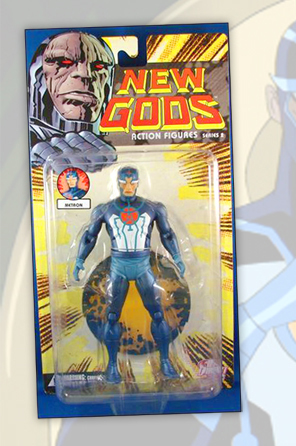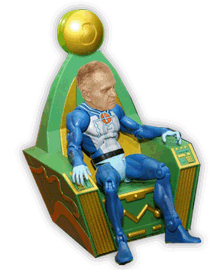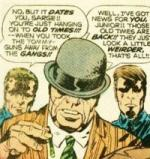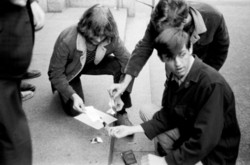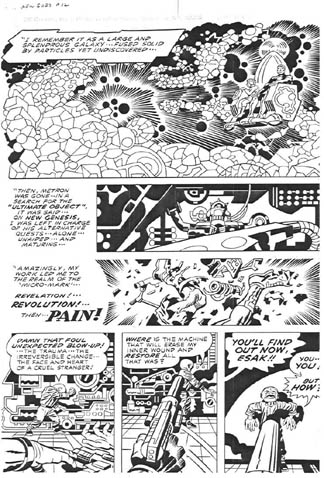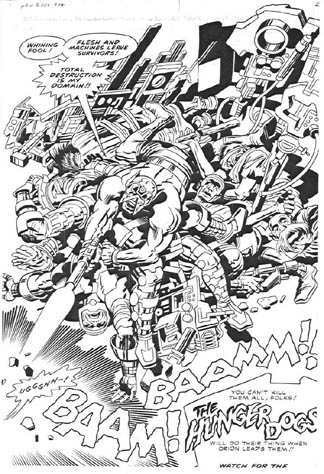Previous – 21. Brand New World | Contents | Next – 23. Why Did The Fourth World Fail?
We’re honored to be able to publish Stan Taylor’s Kirby biography here in the state he sent it to us, with only the slightest bit of editing. – Rand Hoppe
ALLEGORY OF HIS LIFE
But what was it all about?
“There came a time when the old gods died! The brave died with the cunning! The noble perished, locked in battle with unleashed evil!” New Gods #1
Thus Jack Kirby launched his most personal opus. A wonderfully evocative phrase, full of both horror, and promise, for when something ends, something new must emerge.
But just what was Jack Kirby‘s new epic about? Kirby called it a novel about “ourselves”, a visualization of modern man seen through the milieu of the fantasy artist. Utilizing the symbolism and concepts of the super hero genre, to idealize, and entertain, yet at its heart, it was a history lesson, Jack Kirby’s history. Part biography, part subjective observation, but mostly, a sly treatise of 20th Century sociopolitical history as deep and true as any written by scholars steeped in academics and PHD’s.
“The New Gods was my own attempt to create a comic book epic, and this I did. I used four books in which to do it…I filled it with a cast and creations that were highly innovative for the period, and I tried to be as creative as I could. I used the young people of the times, the times themselves became the backdrop of my stories.”
In the manner of Swift, and Twain, Kirby took an art form founded in entertainment, and low expectation, and transformed it into something unique, “graphic allegory”, in fact, I call this “Allegory of his life”.
One has to wonder, knowing Kirby’s haphazard approach to telling stories if Jack had the wherewithal to scope out a story so connectedly. His m. o. was usually one story at a time and let it come to him organically as he sits at the board. I doubt if he purposefully sat down and outlined it straight through, obviously as we are told of how Black Racer came about, he didn’t. But I do think that with the time he had before DC gave him the go ahead that Jack had a basic cohesive structure to the tale. The latter historical type issues seem to have been conceived and executed to tie things into a neater package and the back history might have been subconscious and just a part of Jack’s psyche. But it’s too intertwined to be a coincidence.
“I’ve noticed that throughout the years, each civilization had its own historical facts, its own historical legends, and its own historical ways of storytelling. I began to ask myself the question of “What were the ingredients of our own storytelling- of the storytelling we see today all about us, in the various materials that we read?” With comics as my vehicle for telling a story, I began to set down the kind of thoughts that were common to the period in which I was raised. You’ll find that the elements are mixed, but they have validity and they have the potency of truth.”
The best allegories work on many levels, the big picture, the personal picture, and as entertainment.
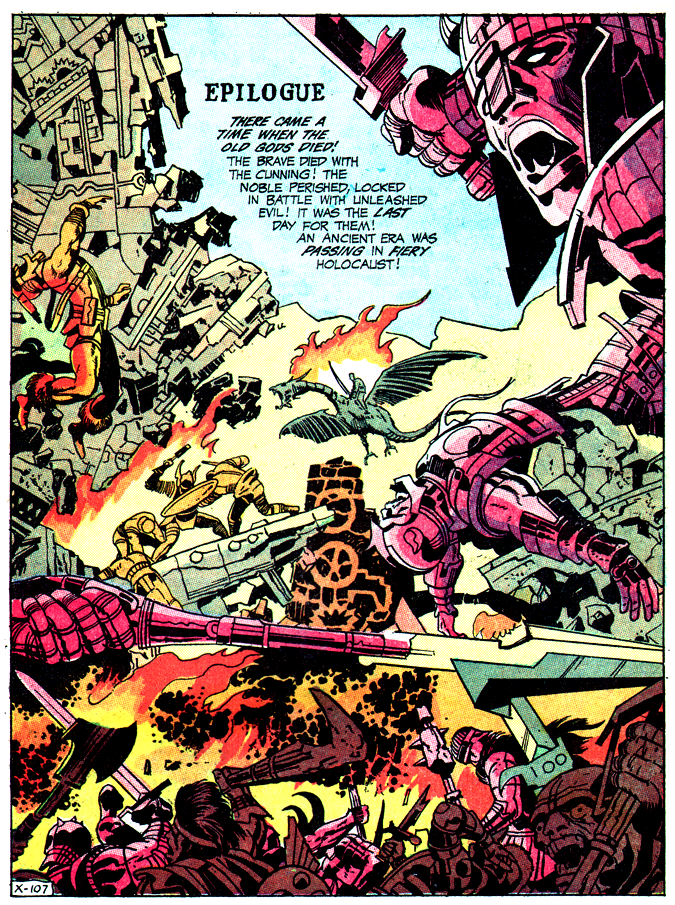
So what do Kirby’s opening lines have to do with his life? Jacob Kurtzberg was born in a period marked by the end of “old gods” Gone were the Czars, the Archdukes, and Kaisers, left powerless were the Kings, and Emperors, whose legacy of absolute authority had stretched for centuries. The age of the feudal gods, lording over personal territories had for all intents and purposes ended. This was Kirby’s birthright.
On a more personal level, in 1970, Jack had just ended a period highlighted by the creation of a universe populated with Gods, and gods. What better way to show the break from his personal past to a new chapter than to literally “kill the old gods”? Few were the readers who didn’t “get” the irony in this audacious beginning. The splash page of New God’s #1 echoes a page Kirby did in the Tales of Asgard stories concerning Ragnarok—the end of the gods.
The next part of Kirby’s opening tells of a…”Final moment came with the fatal release if indescribable power—which tore the home of the old gods asunder—split it in great halves”
When World War 1 ended, the socio-political landscape had been turned asunder. And from the resulting chaos, the world split into two ever-conflicting political spheres, two ideological philosophies at odds with each other. Rule by the people vs. rule by the state. Democracy vs. the ‘isms; one side led by freely elected leaders, the other by the philosophical dictators of Fascism, Communism, Nazism, and Militarism.
Some might say that my description is simplistic, maybe even jingoistic, that the differences between the two sides is far more complicated and nuanced than I make it out. I agree, but this was Kirby’s viewpoint. I don’t think he would make those types of distinctions. His was a more simplistic nature, Nazis were bad, Americans were good. Commies were bad, though he might not be able to say exactly why. He knew of the gulags, he knew of the Berlin Wall, and he knew that they were anti-religious. He didn’t need much more to make up his mind.
Personally, Kirby’s life had always been divided into two camps. Have’s vs. have nots, swells v regular Joe’s, tall v. short, boss v worker, good v evil. Why should Kirby view the larger universe any differently?
Jack Kirby, in his most dramatic fashion boiled it down to its essential. “The fatal release of indescribable power….which tore the home of the old gods asunder…split it in great halves” “In the end there were two giant molten bodies, spinning slow and barren…clean of all that had gone before” He then shows how the two new bodies evolved, one, New Genesis, into a world of light, and enlightenment. Orion calls it “a true place of peace!” where individuals are encouraged to fulfill their own destinies. The other, a demons pit called Apokolips, ruled by an iron fist, and the population, little more than worker drones in service to the state. Never has this concept been more visually powerful, than the contrast between the colorful utopia of New Genesis vis-à-vis the gray, barren, smoke belching pits of Apokolips.
“My conjecture- which is part of good storytelling, I think- still had to do with good and evil, and therefore I contrived an evil world with an evil family, and a good world with a good family.”
Did not World War 2 end in a sudden burst of light and energy, and the victors soon divide the spoils into 2 different worlds?
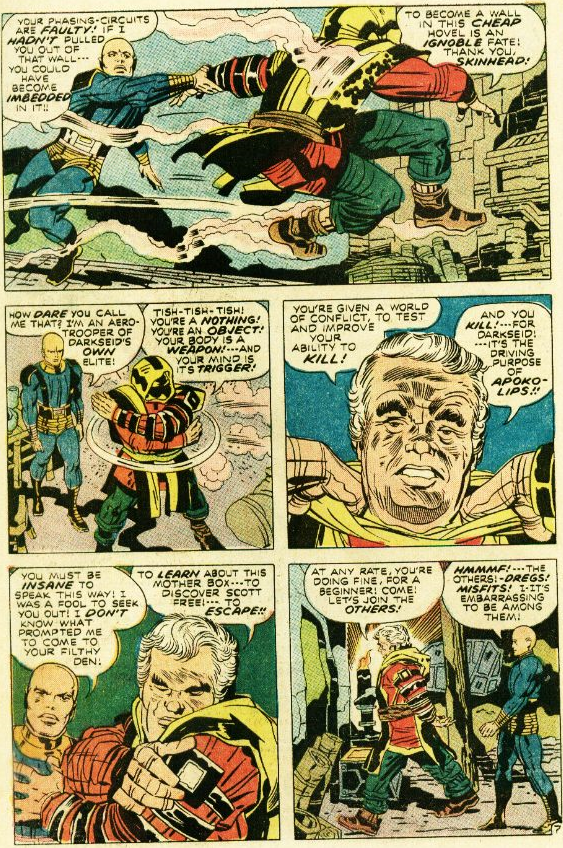
In Kirby’s personal life, isn’t this how Kirby described the latter years at Marvel where he was treated as one of the cogs in the corporate structure? The new owners who had no idea what he had done for the previous regime, treating him like any other artist in their service. Until in a sudden burst of energy, DC freed him from the drudgery. Didn’t he feel that his new position at DC afforded him a chance to be in control of his own creations and destiny, as compared to his time with Marvel where his creations were taken from him and controlled by the dictates of his corporate superiors? Though this may be overly dramatic, we do know that the loss of control of his characters was paramount among the reasons for Kirby leaving Marvel. Kirby’s view of Marvel had become an “us against them” situation. As an aside, unfortunately, DC was not to prove all that “free” where Kirby’s creations were concerned.
From this historical epilogue, Kirby now shows us the world of 1970,a modern world, where a warrior is sent to an unlikely planet to stop the spread of evil by the Deadly Darkseid. The planet Earth has been chosen as the “third world” upon which New Genesis and Apokolips would wage one of their skirmishes in a Cosmic cold war? In the real world, the West and East were locked in an indirect skirmish of their own, our soldiers sent to a small insignificant patch of land called Viet Nam, one in a long list of indirect battles between democracy and Communism known as the Cold War. Jack had jumped forward to a world well recognized by the readers, a battle raging not of our making, and we are helpless to end it.
Kirby, realizing he must first and foremost also tell a riveting adventure builds his suspense by hinting at what happened between the birth of these two great worlds and the cold war that exists today. By not telling it linearly, he allows all the participants little secrets and big secrets that push the tension and draw in the reader He hints at a prior conflict and some unholy maneuver that presents the parties from direct contact. When Kirby does get around to telling the story of Highfather’s and Darkseid’s rise to power, he fills in a history that was all too real for him and mankind in the Forties.
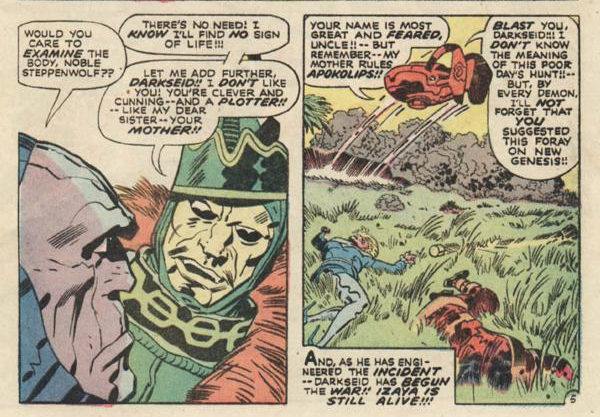
The prior war between New Genesis and Apokolips begins when a small raiding party from Apokolips, led by the Germanic Steppenwolf, attacks an unsuspecting New Genesis couple, killing the woman. We find that this attack was actually suggested by the more cunning Darkseid, in an effort to start a wider war. Did not World War 2 start when the forces of Germany attacked and captured several neighboring countries, all with the backing and connivance of the Soviet Union.
It turns out that Darkseid has actually planned the raid and the man thought killed survives. Izaya the warrior than sets his troops upon the soldiers of Steppenwolf and thus a great war is begun. This war goes back and forth as technology and counter technologies take their bloody toll. When the scientists of New Genesis create a”planet killer” bomb called the Impacter, Darkseid realizes that the continuance of the war is futile, so he asks for a truce. Izaya in horror over the destruction being caused flees into the wilderness until he comes across a great stone monolith. Izaya screams in defiance “If I am Izaya the Inheritor—what is my inheritance? And in a great blast from a fiery hand, the answer comes—The Source. Knowing further battle is futile, Izaya accepts Darkseid’s proposal of a truce.
Though not exact, the parallels between this and WW2 are easy to spot. The two sides battle to an ever increasing mutual destruction until the Allies create a planet killer of their own. After the destruction of Hiroshima, Japan sues for peace. In reality the atomic bomb did end the war with one side victorious, but history has shown that dropping the bomb was as much to signal the Soviet Union to cease aggression and hostilities as it was to defeat Japan. And in reality, the bomb only increased the Soviet will to control.
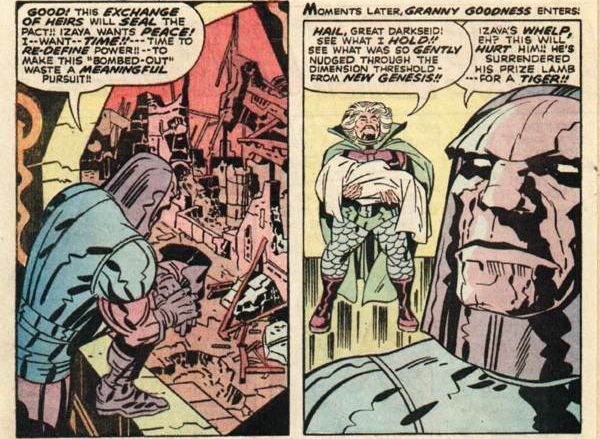
At Potsdam, the combined forces meet to carve up the remains of Europe. To settle differences between the feuding sides, a Pact is proposed where Germany would be cut up and divided between the nations. Each must give in a little to get something. Thus is achieved a shaky peace.
In Kirby’s tale, he simply changes the exchange of land into the more Biblical and literarily dramatic exchange of sons, but the result is the same; a cessation of hostilities and a promise to maintain their own secure areas. By compromising and allowing some to live under a despot so that some could live under the banner of freedom, the larger war was averted. But just as Kirby railed against Chamberlain’s acquiescence at Munich, Highfather knew that the Pact could never last. It is the nature of the despot to seek to expand their influence over the rest. It was just a matter of time before an attempt into the neutral territories would create tensions and open conflict result.
“Good and evil are always in contention, and each will forever try to cancel out the other. This lies behind the path we all tread. We live our lives out making the decisions that will clear up the dividing line between good and evil.”
This brings us back to the present day stories of the Fourth World where we see that the cold war between New Genesis and Apokolips has expanded into a neutral territory, the planet Earth. Darkseid had kidnapped some humans in the hope of finding the anti-life equation, and Orion of New Genesis is sent to stop him, and the fate of Earth is insignificant. Yet they do not face each other directly. Not unlike Korea, Viet Nam, Cambodia, and other small countries caught in the philosophical war between the East and the West. One side makes a move and the other side must retaliate in an endless chess match cycle that eventually destroys the host country.
In an allegory, many times people are merely symbols of real people, events, places or concepts. This humanization gives them form and depth with which we can easily recognize and react in the manner that the author wishes us to.
“There’s got to be a variety of characters in order to make clear and evaluate your own social values. So I had my own cast.”
As was common at the time, almost any mention of a cruel dictator would raise the specter of Adolph Hitler, and Kirby’s tale was no different. Jack often spiced these stories with Nazi codewords and quotes. But Darkseid in my opinion wasn’t a Hitler. Steppenwolf was the standin for Hitler, and like Hitler died at the end of the middle war. Drakseid was much more philosophical and Machiavellian than Hitlers’ straightforward boorishness. Steppenwolf was the fist in the face, while Darkeid was the shiv in the back. He reminds me more of Joseph Stalin, and the network of Soviet duplicity, and it seems that Kirby’s references are more Soviet style despotism than Hitler’s nationalistic fervor. Hitler was trying to raise Germany, while Stalin’s evil was much more personal and ideological. Nowhere do we get the feeling that Darkseid cared one whit for Apokolips and its people, they were simply cattle for the slaughter in the service of Darkseid himself. He didn’t want land, or wealth, he wants control of the very thought process of his subjects, this strikes me as more in line with the way Kirby would view Communism. When Khrushchev said “we will bury you” he wasn’t talking militarily, he was talking from a rot emanating from our insides; the destruction not of our homes but our way of life and philosophy of freedom and independence. This is a big difference between Darkseid and Kirby’s other great megalomaniac Dr. Doom. Even Dr. Doom had a soft spot for his beloved Latveria.
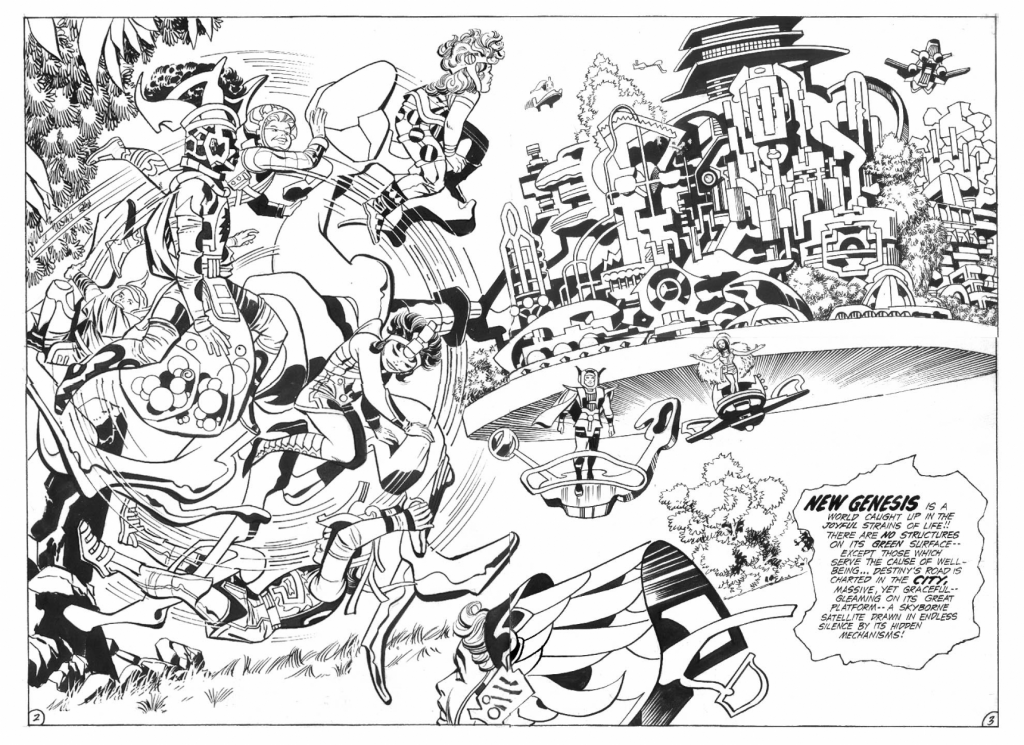
“Darkseid is what we mean when we say “the powers that be”; not satanic, not merely the devil. He is what we mean when we say “them” but what we really mean is “us”. Darkseid is what happens when everybody is asleep. Darkseid catches you off guard; he isn’t reckless he is far from being a raving lunatic with his finger on the trigger. In fact, he is just the opposite. He is the perfect rational man that we put into power because we are either too lazy to pay attention or we’re too occupied to worry about such details.”
Though Jack did pepper his tales with Nazi allusions, such as comparing DeSaad’s Happyland camp to the Nazi concentration camps, the actual methods used were more similar to the mind breaking techniques used in Korea or the Soviet gulag system. The idea was to break the will and spirit more than the body.
In allegories it’s not always easy to pigeonhole every actor and point to his real life counterpart-either a person or a country or a concept. Darkseid is easy, we all recognize the bad guy and the role he plays, Kirby said think of him as “the dark side of the moon.” Good guys are sometimes more nuanced. Does Orion represent a specific country or person or concept? I don’t think so, he is clearly the hero, but he is an imperfect hero. He doesn’t represent the American way of life, his calling is more emotional than patriotic, though I do think Kirby saw America as an imperfect concept. Orion was a junkyard dog, complete with floppy ears and a snarl. He is a warrior born, not one forced by circumstance. He shares aspects with the East European freedom fighters, in that he came from a place of madness and wants to get out. His battles are internal, a rage boils in him and he can only control it thru a mechanical construct. His battle is a search for identity, to see just where he really fits in, the fight to reconcile his opposing natures without flying apart. He is one of Kirby’s more complicated characters, there are no easy answers. But his instincts are good and he knows right from wrong. Through the years many of Kirby’s heroes have been aspects of Kirby himself. Is Orion part Jack Kirby? the battler fighting to get out? Perhaps somewhat, but not so one can clearly say he is Kirby personified. Maybe he was Jack’s father.
“Orion is your old man. He was half monster and half good guy. How many scars does your old man come home with at the end of his day’s work? Orion is a reflection of that. A guy who was scarred, but wouldn’t show you.”
He does share inner rages with Jack, but from different sources. Perhaps Orion’s warrior face is Kirby trying to show the messiness of war. His way of letting people know that war can’t be prettied up and made palatable. As Robert E. Lee said “It is well that war is so terrible, or we should grow too fond of it.”
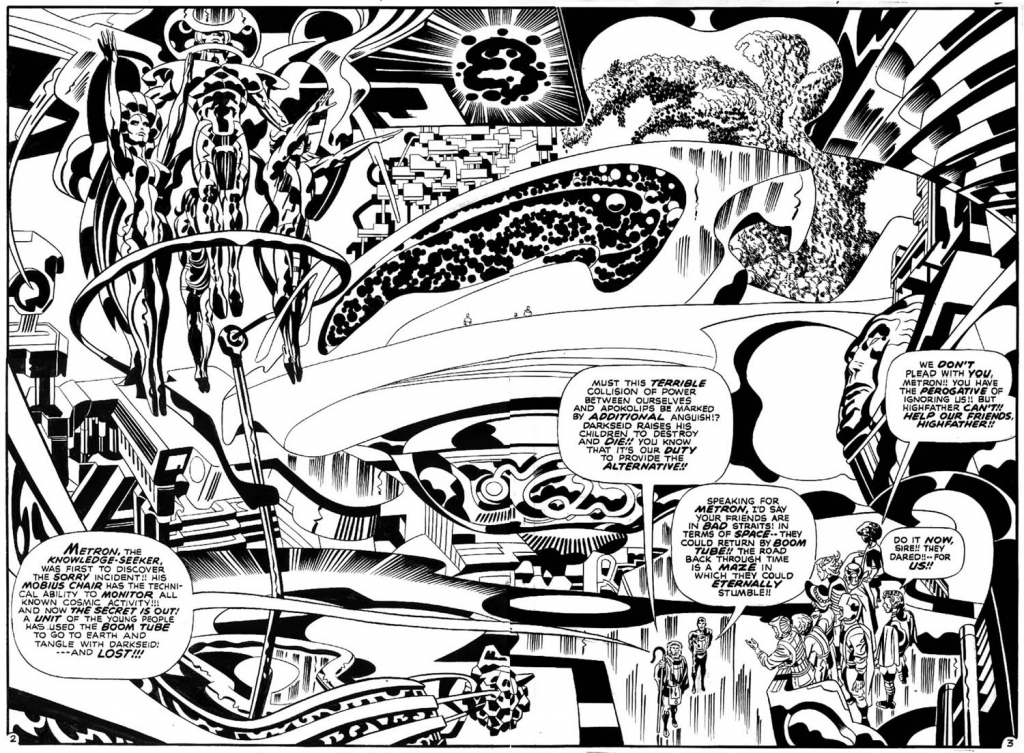
“The key element of my story was Orion, who left his evil world to find his true roots, which were embedded in the planet of Highfather. “….Orion went to the place he thought he belonged, and he tried to find the people to whom he really meant something” “…I believe, in every person. There comes an inner explosion which gives us the strength of ten; and nobody is prepared for that-even Darkseid.”
Orion’s constant companion was Lightray; as brash, exuberant and optimistic as Orion was sullen and dour. Lightray was Kirby’s ode to unbridled enthusiasm and hope. He had an innocent and trusting spirit. His job was to show the other side to Orion and offer another choice away from Darkseid. Darkseid hated his cheerfulness and optimism. Lightray was the angel of our better nature Lincoln espoused.
“Lightray, of course is a light-hearted character, and enjoyed life; and we see people like that every day. They cause no harm, and they devise and make use of all the wonderful diversions that lighten our lives. What they can’t find for amusement, they will create for amusement. They will not live their lives in vain; they will try to enjoy life.”
Highfather is another interesting character. First seen as the warrior king Izaya, he makes a Biblical trek into the wilderness and returns the philosophical leader with a direct connection to the well of knowledge known as the Source. The graphics are straight out of Cecil B DeMille’s Ten Commandments. The black hair and beard now turned white and the long flowing robes and shepard’s staff of a flock leader- a Moses. The Source is shown as a flaming hand much like the one that wrote the commandments. He, more than any character, was Kirby’s vision of goodness. But he was not perfect, which reflects Kirby’s Jewish roots. The Jewish kings were always presented as good, but flawed.
“Highfather is our conception of a being who gives us our total goodness, and of course that being comes with many names, in many languages on our own earth. Highfather- the opposite of Darkseid–receives Orion, who is his own true son. Of course that heightens the situation and makes it ready for adventure.”
Does that make Highfather a rabbi? Perhaps to some extent, but I see him as more of a warrior king like David or Saul. He definitely draws from Kirby’s religious nature, but Highfather was not a weak, pacifistic Mahatma Ghandi type, no, he was more of a Jefferson, secure in the knowledge that “The tree of liberty must be refreshed from time to time with the blood of patriots and tyrants.” Highfather knew and understood war, and he didn’t flinch from his duties, and that was to send Orion into the dragons’ mouth.
“..but, as good as he is, Highfather is betrayed by his own overconfidence that peace is everlasting. Like Prime Minister Chamberlain. Highfather learns that wisdom and kindness are not always good positions to keep in the face of a mortal enemy. Highfather failed his own people because he could not conceive that Darkseid would go to war again. In his mind a pact is a pact, but to Darkseid, it is a means to accomplish an end.

I think if Highfather symbolizes any one thing, it is that man can rise above his barbarian/warrior persona and become unto a God, but it must be thru a rite of passage that leads him to faith and goodness; perhaps a little Franklin Roosevelt battling thru paralysis to become an inspirational leader. Only one person in the Fourth World saga actually had direct contact with the Source, while others, such as the evil Darkseid, and the faithless Metron were stopped from reaching the Source by a barrier. Is this Kirby’s way of saying that power and knowledge have limits and the next step can only be achieved through absolute faith? Is this not the most basic tenet of most religions? Unfortunately Highfather was never fleshed out by Kirby so he remains unfinished in my mind.
Into this dysfunctional family is thrown a fourth element, the son of Highfather given over to Darkseid to raise as his own. Scott Free is man’s eternal desire to be free. He has a love of freedom that no ideology can bend to its will. This is the power that would bring down the Berlin Wall piece by piece. This is the strength of will that all dictators know must be tamped down and destroyed if they are to hold power. His is the purity of consciousness that draws people to him, and transforms evil and doubt into purpose.
“Mister Miracle, the magician, became his own magic. He was the one Orion was traded for, and he would never be the kind of character Darkseid would ever consider an ally.”
Himon is another iconic creation; part liberator, part mentor, part revolutionary. As a liberator, he seems to mirror the brave religious underground of Central Europe who helped ferry people under the bridges and around the barb wire. He was the hope that springs from religion at its most basis level. And the fervor with which Darkseid’s troops track him remind me of the fear that faith can undo despots and tyranny. Kirby uses a similar setting when Wonderful Willik tells the lowlies that “they have cornered a worm among you.(Himon) “eating at your lives and spirit and meritorious work.” Note the connection between spirit and work and remember that Communists believed that man was fulfilled only thru work and that religion was an “opiate of the masses” that dulled their enthusiasm and destroyed free will. Kirby seemed to be reaching for a Judeo-Christian vibe in the Himon story. Himon is shown as being pacifistic in his response to attempts at executing him. He never physically fights back, he simply vanishes. When Himon takes Scott to his den the group image resembles the Last Supper of Christ, even to the point of having Kreetin (a great name) deny his allegiance to Himon- much like Peter of Christ- after Himon is captured and led away to be tried. . Is this a real intent of Kirby the Jew, or simply dramatic license? The mentor aspect is easier. Himon plays a large part in Scott Free’s life, he encourages the kids to blossom and seek their freedom, and it is Himon that shows them the path to hope. How similar in nature to how Jack Kirby described his mentor, Harry Slonaker.
“He thought that if he gave kids responsibility it would give them hope, and there was so little hope then.”. “We learned responsibility. For the first time it was in our own hands, and we learned how to deal with it.”
How similar to Himon’s last words to Scott Free. “If he leaves Apokolips, he will find the universe.” Revolutionary in that he taught the children of his coven that there was a different life available, but they would have to fight for it, and he taught them how to create the machinery needed for this fight, not of the warlord but of the mystic and dreamers as seen in Aurelie’s “mind-video” that allows her to dance and play. Himon says that “Auralie’s thoughts are beautiful! She creates beauty! Imagine doing this on a world like Apoklips. Himon knows that to defeat tyranny one must first free his or her own mind of evil ideas. John Lennon said it best “You tell me it’s the institution Well, you know, You better free you mind instead”
There is a cryptic side to Himon. Several times he bemoans the fact that he somehow created Darkseid, or at least the factors that led to his rise. “I fostered Darkseid’s power! I must be here at its end” was just one example. Kirby never showed a specific connection between the two so we can only speculate as to what he meant. I wonder if this was Kirby’s way of acknowledging that the factors that led to Communism were noble, and no one could have seen that it would be much worse than the rule of the Czars. The people who overthrew the Czar wanted freedom just as much as any other people. Was there a back story that would show that Darkseid’s family came to power when Himon and the people overthrew another evil dynasty? I don’t know.
Himon was also a wonderful foil to the cold calculating Metron, Even the physical differences where Himon is soft and cuddly vs. the icy Metron’s angular and rigid form. Metron was one of Kirby’s unemotional observer archetype, but he was more, he was science run amok. He was the fear that science was moving so fast that we could no longer control our human side. Metron was amoral- he cared not which side he was making weapons for, or what the consequences. Metron was based on the cold aloof Dr. Robert Oppenheimer, director of the Manhattan Project who once famously said; “When you see something that is technically sweet, you go ahead and do it and you argue about what to do about it only after you have had your technical success. That is the way it was with the atomic bomb.” To Metron the time to worry was after the barn door was opened. Yet Kirby was also aware that for humanity to grow, Metron’s knowledge was essential, so Highfather kept him close, and somewhat restrained. Eisenhower’s Military Industrial complex speech might be a good example of Kirby’s concern. Metron was also Jack Kirby’s unending search for answers; he always turned to Metron when highlighting the philosophical/spiritual context for the Fourth World. Robby Reed, on his essential blog “Dial B for Blog”-now at 600 posts– took this Metron as Kirby idea even further.
The Newsboy Legionnaires remind me of Jack the person, but the character who reminds me most of Jack the visionary artist is METRON of the New Gods. It might seem strange to say that — but think about it. Metron is a man who sits in a chair that can go anywhere in time and space. Isn’t that just like JACK KIRBY sitting at his drawing table, on his own private “mobius chair”?
The resemblance grows stronger if you know that Jack did a sort of prototype for Metron’s Mobius Chair in Alarming Tales #2, November 1957, in a story called “Donnegan’s Daffy Chair.” In this story, Donnegan is a janitor who borrows a “daffy” magical chair that takes him flying far beyond earth, and into outer space.
As you can see below, Donnegan is a dead ringer for young Jack Kirby, and his “daffy” chair comes complete with its own built-in mini drawing board! Metron should consider adding one to HIS chair. Or at least a seat belt.
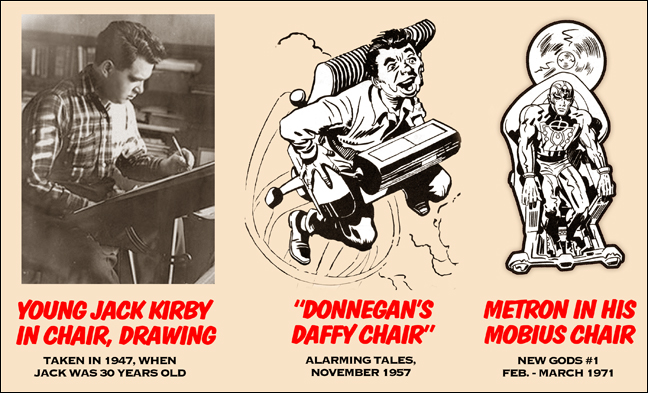
So you see, Jack Kirby IS alot like Metron! When Jack sat on his chair, pencil in hand, he could travel anywhere and everywhere. And, as we all know, Jack Kirby not only “could” — Jack Kirby DID!
Wherever his characters went, Jack went there first in his imagination. He knew those people first. When he put them down, they had already lived, both in his imagination, AND in his own real life. Jack Kirby — THE TRUE ARTIST — used the medium of comic books to envision different periods of his life, creating new worlds each time he refined that vision.
Robby Reed’s favorite action figure
Glorious Godfrey is an enigma. We know he was based on both Billy Graham, and Arthur Godfrey. While Billy Graham was the great evangelical of the middle century, who wheedled his way into the very seats of power-a harbinger of the religious right. Godfrey was the most famous pitchman in America- the man who sold America everything from cigarettes, to shaving cream. A man trusted by the mothers of America because he had a pleasant manner and calm voice. But in reality he had a bad attitude and a penchant for firing on a short fuse. He was also accused of being anti-semitic, though it seems unfounded. Kirby had an innate fear of Christian leaders who sought political power. His view towards Christianity was similar to many elderly Jews. He loved the teachings and the philosophy that are the bedrock of Christ’s teachings, but he feared an organization that once it obtained financial and political power has been easily swayed by the current powers that be. A philosophy too easily swayed to fit into whatever mandate sought by the ruling party. Many Jews remembered how long it took for the Pope to speak out against Hitler, Mussolini, and the holocaust or how easy it was for Southern preachers to find arcane phrases in the Old Testament to buttress the rights of slave holders. Jack seemed to fear that a smooth talker with fanatical religious beliefs might come along and take control; a fear that echoes even today.
Terrible Turpin, is obvious – he is us. A common man who reaches a turning point when he says enough is enough. He is the collateral damage of wars between super powers. He is also the spirit of survival. He is the undying spirit of humanity, as much as Captain America or Sgt. York. In reality he is the fireman running upstairs as the tenants are running down the stairs; the cop on the beat who puts his life on the line everyday, or the soldier who jumps on the grenade to save his buddies. To many, Ben “Terrible” Turpin was Jack Kirby as everyman. It was Kirby who stood up to the cosmic mayhem, just as he did the Nazi’s. Bruce Timm, when animating the Fourth World in the Superman cartoons, spotlighted this idea.
TJKC: Was Ben Turpin based on Jack?
Bruce: Oh, definitely. Absolutely, it was based on Jack. That’s something DC Comics had been doing for a while anyway, using the stuff that Jack created: The Fourth World characters, Intergang, an all that stuff. They’ve really been introducing that stuff in the Superman comics recently. We thought that’s a natural; we love Jack’s stuff anyway. The Turpin character in the comics didn’t look anything like Jack but I decided it would be kind of fun, kind of a little throwaway tribute to Jack, to make the character look like Jack.
“Now no soldier in his right mind would face a battalion of Panzers (German tanks) alone; even one would be suicide, and I just said that like I myself had done it. Some people think I’m crazy, but I never did anything like that, but there were guys who did. You can read about them in history books, and that’s who Turpin is. But still, he is the essential character of all mankind, to stand up against all odds because nobody else would do that job. There’s always one who will, and when we run out of people like that, that’s when we’re all going to be in trouble.”
I should mention Superman, though not a Jack Kirby creation, Jack does involve him into the Fourth World aura. To Jack Superman was not an invulnerable do-gooder standing outside the world looking in. Superman had great powers but to Jack they made him lonely, isolated and questioning as to his rightful place in society. Jack gave him a depth no other artist/writer managed. When asked about his Superman Jack answered.
“The bottom line involves choices. Neither gods nor humans have ever stood calmly in a minefield forever. Good or evil, they are bound to choose. And when they do, you will see the truth of all that motivates us. As a thinking being, you have the obligation to choose. If the fate of all mankind were in your hands, what would your decision be? “As a writer and an artist, I’ve drawn my answer.”
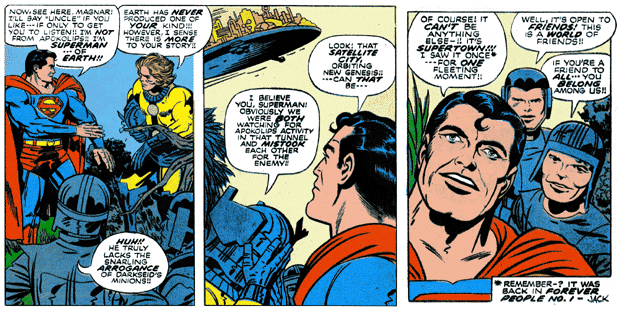
I hesitate to mention the Black Racer, but I guess I must. The hesitancy is because I have never figured out what role, what symbolism or what exactly Jack was getting at. Obviously he represents death but what aspect. In other mythical tales death played a role in separating heroes from the rest. Hela took the heroes to Valhalla while sending the rest to Hades. Judeo/Christian myths are similar with a separate heaven and hell. But Jack never shows us any reward in his tales for a valiant and glorious life, or punishment in the hereafter for the evil. Death was as random as it seems in real life. Perhaps Jack was becoming existential in his later years. His battle scenes remind me of a lyric from the Broadway Show “Civil War”.
”And the heroes and the cowards look the same when they have fallen by the gun”.
But I don’t see Jack as existential, he was an optimist, The use of a paraplegic Viet Nam Veteran as the personification of death makes me think that Black Racer was his reaction to seeing the constant rain of dying youth on our TV’s at news hour. The few times we see the Racer offers no clues as to his purpose in the tapestry. He is intriguing but I think I may agree with Mark Evanier when he told Jack that it was a good concept, but probably not at this time. Of course Kirby had his own reasons, and I’m sorry I can’t divine this one; it’s probably a good one. His costume needs to go; a Black skier in medieval armor is too much even for me.
Several players seemed to be fevered images of real people from Kirby’s life. Funky Flashman and House Roy were obvious spoofs of Stan Lee and Roy Thomas, and their evil doing was hucksterism in the service of Darkseid. While some, their natures were revealed just by their names: DeSaad, Vermin Vundabar, the Justifiers, Beautiful Dreamer, Simyan and Mokkari.
From this point on it seems that the stories were observations and morality plays based on Kirby’s response to world events and social currents of change swirling around him. In the very first Jimmy Olsen story Kirby shows us a mysterious Wild Area populated by long haired mystics, and motorcycle thugs, and a wild psychedelic underground government research center conducting crazy experiments. Is this not Kirby responding to the hippies, and counter culture, and the backyard motorcyclists who bothered him incessantly and the scientific research that was changing the landscape, some for the good and sometimes not.
Kirby spends a lot of time detailing the differences in the educational facilities of both New Genesis and Apokolips. New Genesis children are shown outside in a casual almost Platonic setup with flowers and birds and a happy exchange of ideas, while those on Apokolips are shown huddled in the clutches of Granny Goodness, a sadistic warden beating the children into strict obedience and indoctrination into the ways of Darkseid. Many are the stories of the time showing experimental open classes in enlightened US schools as compared to the harsh, Soviet model where children were taken from their parents and trained for specific tasks, and indoctrinated into Communist philosophy. Kirby wasn’t always subtle, his rendition was much more graphic and terrifying, but no less obvious to its template. It should be noted that New Genesis seems more of a hippy flower power commune than a real world cityscape. Perhaps Jack bought into the love, peace and happiness claptrap somewhat. Apokolips for its template think more of the coal pits and slag heaps torn into the side of the West Virginia mountains combined with huge burn pits belching smoke and brimstone into the smog filled Ukrainian rubble.
The control of the media and by its nature the access to knowledge also gets the full Kirby treatment. The first of Darkseid’s fifth columnists was Morgan Edge, who has taken over the Daily Planet and controlled the news network. Several attempts at mind control and Manchurian Candidate style stories appear, only to be defeated by New Genesis’ agents. Kirby even takes on the right wing religious ascension by the likes of Billy Graham and right wing hucksters with characters like Glorious Godfrey and Funky Flashman. The Funky story is also a not so subtle jab at Stan Lee and Roy Thomas. Instances where Jack threw in personal swipes were few but obvious.
Perhaps in response to Israel promoting the role of women in their military, Jack introduced a fighting squad of “female furies”. Led by Kirby’s most intimidating female character Big Barda, an example of East German style chemically induced Olympic athlete. Originally a fighting force for Darkseid, they switched sides and joined Mister Miracle in his battles against Darkseid’s minions. With the likes of dominating Lashina and lunatic Mad Harriet they were as nasty and as formidable as any Kirby military group ever seen. It’s a close call whether it was safer to be a friend or an adversary of this group. They bickered more that the Thing or Torch ever did. Big Barda was Nick Fury in drag, with a body by Jayne Mansfield, a face modeled after songbird Lainie Kazan, and a disposition like Alexander Karelin, she was heads and shoulders above any fighting female drawn by Jack. She was the Goddess Sif, on steroids. Amazingly she didn’t smoke a cigar. Her protectiveness of Scott Free was eerily reminiscent of Roz and her Jackson.
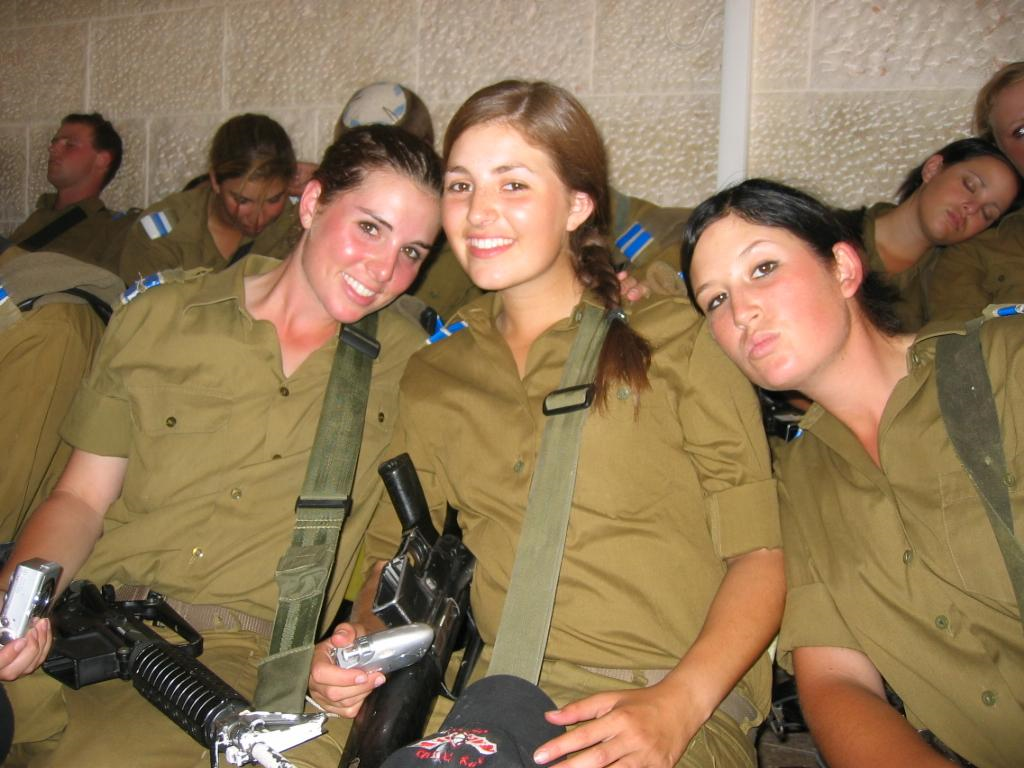
The real female furies of Israel
“Big Barda is the female star of the story, and a girl who is both vital and brave, and has everything we might want to find in the perfect female. I tried to create a female vision of this sort, and I think I found it in Big Barda.”
The antiwar movement received Jack’s attention, not only with the pacifistic Forever People, but in one of Kirby’s best stories. In New Gods #6 entitled the Glory Boat he presents a family broken apart because of the inability of a hawkish father and a peacenik son to unite. Thrown into an Apokoliptian nightmare, the son proves his courage and the father faces his fears in a poignant story faced by many American families with sons hiding in Canada, and thrown in jail for refusing induction into the military. Kirby fought this same battle.
Neal tells of Kirby’s feelings on the Viet Nam war:
“You’d classify him (Jack) as a liberal Democrat. During Vietnam he was very much against the whole thing; right from the start. It was no mystery to anyone in the family how he felt about it. I had some friends over, and we were all watching the draft lottery on TV. He told me. “Listen, if you draw a low number, and want to finish school in Canada we’ll support you 100%.” He didn’t want me to go at all.”
Terrible Turpin aka Jack Kirby – Playing with matches
The sadness and bravery of freedom fighters around the world bent on defying both East and West gets its due in Kirby’s best tale, “The Death Wish of Terrible Turpin” from New Gods #8. It tells of a Metropolis cop who finally can’t take anymore of these two super powered foes battling it out in his town, leaving death and destruction behind them. He says enough is enough and wades in to stop the fight barehanded. Despite his being human and the enemy super powered he holds his own until the battle ends. with Turpin looking much less for wear. His bravery is never maudlin or phony, his rage is understandable and his action laudatory. For once the super powered beings realize that their fight impacts others and not in a good way. Nothing reminds me of this story as much as the photo of a lone Czech patriot standing up to a Soviet tank in the middle of a square. Is there anything more powerful than one person standing up and saying “no more”? The bracketing scenes of Orion spilling his guts to Lightray are gut wrenching and provocative.
The country was burning over a fight for equality, and Kirby had to address it head on.
The East would point to the race problem in America whenever the hypocritical West would belittle the East for the living conditions of its people. In “The Bug” from New Gods #9 Kirby presents a view of New Genesis’ racist underbelly. While the elites live on a beautiful floating city high above the planet, a lowly group of scavengers and worker bees live on the surface. They are hated by the swells in the sky. They live off the refuse from above and one of them yearns to be free and better himself. It is hard to read of Orion and other New Genesians spitting out their hatred for this race, and call for an ethnic cleansing, but Kirby needed to show that no one is 100% good or evil. New Genesis was a planet just like ours populated with people who were super in power but capable of smallness in their hearts. This may even be a nod to the internment of the American Japanese population during World War 2 (including his letterer extraordinaire Ben Oda) and the easy bigotry shown during our fight to free other people bent and broken by prejudice and bigotry. Surely Kirby’s pride as a Jew helped him out during his darkest hours in Europe.
The art ranks right at the top of Kirby’s long career. He used the whole canvas, the backgrounds and the location scenes were astonishingly dazzling. His machinery, especially in Mister Miracle was awesome to behold. His characters had mass, and depth. There doesn’t seem to be any throw-away panels, every inch is used to tell the story. Jack took a new interest in fashions, where all too often during his Marvel days Kirby would fall back on drawing fashions from the Forties, Kirby seems determined to keep these series topical and up to date. When he does do a throw back, such as Terrible Turpin, and his derby, it seems like a perfect choice for the old-school personality of the bulldog policeman. His characters had the ability to shock you, yet still remain true to their nature. In the final issue of New Gods, while Kalibak and Orion are fighting, we see Darkseid watching from afar. When he realizes that DeSaad has unfairly assisted Kalibak, Darkseid confronts him and in his anger wishes DeSaad out of existence. Is this Paternal feelings or just a semblance of fair play from deep within his evil bowels, we really don’t know. Perhaps it is simply that Darkseid can’t abide someone else playing god. That is reserved for Darkseid alone. Whatever the reason, it shows another side to his evil. Kirby explained that this new found depth came about because the story propelled him to new heights. Kirby’s background characters and figures took on greater importance and energy.
“In the New Gods, (short hand for all the titles) I became aware of the amount of detail that was important in telling the story. By detail, I mean environmental detail, background detail, the crowds, the buildings, the feeling for the times. In doing so, I found my drawings tightening. I found my drawings becoming more illustrative and better than I’d ever done them before. I have the New Gods to thank for that.”
The one overarching problem with talking about the Fourth World is that Kirby never had a chance to finish it. The Hunger Dogs, done much later seems too slapdash and cartoony to me to be of real help. It doesn’t even deal with Scott Free, and Metron and the Forever People and the fate of so many others. Could Kirby have worked out the anti-climatic fall of Communism of the Soviet Union to fit his need for a climatic ending for an adventure tale? Could he envision Darkseid acknowledging defeat due to failure of his philosophical convictions? Would Intergang, and the other thugs go underground like the Russian mafia? This is of course a weakness in making people symbols of philosophies; an individual can easily adapt and accept change, ideologies can’t.
It’s really hard to overstate the role that the immediate times played on the tapestry that Kirby was weaving. The social upheaval and the scientific changes occurring almost daily was the fodder that kept Kirby’s epic so enjoyable. It was like we were looking into some psychedelic mirror that turned and twisted the world and then broke into a thousand different shards reflecting aspects back at us. The final words on this should probably be Jack’s.
“I wouldn’t say my drawings were illustrations of any kind, but they were great comic drawings, and they fulfilled the kind of goal I was reaching for in all my years of doing comics. In doing Captain America, I’d concentrate on doing a few figures, and tell the story correctly. The figures were active; they bounced all over the page, but they needed very little background. In telling the story of the New Gods, I told an entire story. I gave the entire picture of the events which transpired. In that way, I feel I have made a giant step in dealing with my own creative ability, my own feelings for people, and my own vision of the future…. So I consider this a great accomplishment, in the field itself. It was a story that was fully rounded, with people, with backgrounds and with the satisfaction of innovation.”
“To bring this to a conclusion, I’d like to say that I felt the New Gods were our gods. They were not the gods of the medieval ages; not the Greek gods; nor the gods that came before them. The New Gods were the kind of people that made our own millennium. We live in the age of the New Gods, and the New Gods are still developing. So I felt they represented you and I, and the people we know; the people of our time. They represented the 1970’s and they’ll probably go on from there.”
I lied; the final word will be by Willie Shakespeare, who said a few words about us and gods. “What a piece of work is man, how noble in reason, how infinite in
faculties, in form and moving how express and admirable, in action
how like an angel, in apprehension how like a god!”
Jack Kirby gave us our Gods.
But interpretation is not for me alone. Artist James Romberger wrote some words on the New Gods and its follow-up stories.
Undiscovered Particles
by James Romberger
from the Jack Kirby Quarterly #15, 2008
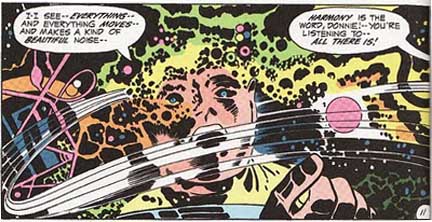
A young mind is blown, from Forever People #2
The Fourth World is Jack Kirby’s grand concept, the project in which he invested the prime of his skills as well as his highest hopes and ambitions. Kirby’s saga debuted in 1970. He hit the ground running; within a few issues his writing became more confident and he began to draw with unmatched clarity, grace and power, brought into focus by Mike Royer’s exemplary inking. Kirby put forth a very thoughtful and humane writing that helped form many of his reader’s views of the world. In this way he transcended the entertainment realm of comics to create something much more meaningful.
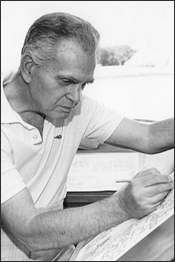
He filtered his own experiences with violence into a philosophy that extended across his epic, from Orion’s attempts to overcome his aggressive nature and the examination of the principles of conscientious objection in “The Glory Boat,” to Mr. Miracle and Big Barda’s rejection of their military programming. In Kirby’s comics pathos is contrasted with irony to create relief, a classical formula he used effectively. The best stories of the 4th World read as literature.
For a variety of reasons, the 4th World was cancelled by DC before the end of 1972. The loss of his developing masterpiece as he was just reaching a career peak of performance hit Kirby like a hammer blow, according to those close to him. He went on to create other significant works, but rarely again touched the glorious synthesis of story and art seen in the best of the New Gods. DC owns the characters and concepts and uses them in combination with their other corporate properties. In 1982 DC’s Jenette Kahn and Paul Levitz offered Kirby creator credit and a percentage of royalties for the Fourth World for redesigning it for use in the Super Powers TV cartoons and toys, a gesture that meant a good deal to Kirby and his wife Roz. DC also offered him twenty-three pages to write and draw a conclusion to his story in the final issue of reprints of his original New Gods comics. Within the limitations he was given, Kirby produced one of his last great stories, “On the Road to Armagetto”. Unfortunately, it was rejected by DC. Kirby amended the story, and it was inked and lettered by Mike Royer. Its pages were later distributed in altered form throughout Kirby’s 1985 graphic novel, Hunger Dogs. Sadly, with DC’s recent reprinting of Hunger Dogs in their 4th World Omnibus Volume 4, that story remains unavailable to be read as he intended.
For his conclusion, Kirby chose to focus on something meaningful that was possible to bring to succinct resolution. One of the most significant themes present in Kirby’s complex, interwoven plotting in the 4th World is that he absorbed the aspirations of the psychedelic movement, and recast it in his own image. In 1970 Kirby was aware that a key demographic for his work was the college-age kids that had embraced his Marvel work. He created characters for DC that were geared to and reflected that market. The first of Kirby’s new comics completed on his board was The Forever People #1. The dreams of the flower children had been occluded by Charlie Manson and Altamont the year before but you couldn’t tell from the optimism Kirby invested in his super-freaks.
The Forever People is about a small unit of young New Gods who join their planet’s war, but deal with crises using technology, compassion and their individual skills. The Forever People as superheroes are an idealized version of what hippies should be: calm, gentle and intelligent. In cases where they are unable to cope, they join to form the Infinity Man, an entity of indeterminate power and personality, however, this device was diminished as Kirby progressed. Simultaneously, Kirby took over a staid DC title, Superman’s pal, Jimmy Olsen. Square Jimmy suddenly seemed truly young, hurtling at breakneck speed into Kirby’s ominous interzone of psycho-cosmic warfare. Kirby came up with many inventive ideas from the world around him, distilled from current events, hit films, and scientific magazines. He explored the then-nascent science of genetics with his “DNA Project,” a U.S. Government operation that could endlessly generate the types of imaginative Jimmy mutations the title was notorious for, and also created “The Hairies,” a commune of technologically advanced “DNAlien” clone hippies who travel a tunnel complex called the “Zoomway,” in a dragon-decorated missile carrier known as “The Mountain of Judgment.”
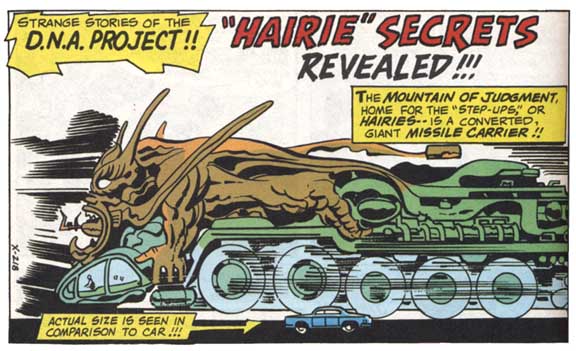
The Hairies’ Mountain of Judgement, 1970
Kirby’s hippie characters may have been inspired by the real-life pioneering exponents of psychedelia, the Merry Pranksters. This may be supported by the fact that the Pranksters were, like the Hairies, the result of a Government experiment. Prankster founders Ken Kesey (author of One Flew Over The Cuckoo’s Nest), Ken Babbs, and Stewart Brand (later editor of the Whole Earth Catalog) all attended Stamford University in the late 1950s and there participated in tests of LSD by MK-ULTRA, a long-running mind-control program overseen by scientists under the wing of the CIA. Kesey and his fellow subjects were so impressed by their experiences on acid that they became advocate distributors of the drug and facilitated the rapid spread of psychedelic culture. They believed that LSD could change the world. They threw the earliest public Acid Test parties in San Francisco in collaboration with the Grateful Dead. The Pranksters’ acid-proselytizing tour of America on their psychedelic bus “Further” was reported by Tom Wolfe in stream-of-consciousness style in his famed 1968 book The Electric Kool-Aid Acid Test.

Kirby’s Thor on Acid Test flyer, and the Merry Prankster’s bus Further, 1966
Kirby’s work figures into the Prankster’s saga: Wolfe writes that Kesey is frequently consumed in reading Marvel Comics, and a Kirby drawing of Thor is prominent in a Prankster poster for an 1965 Acid Test. Kirby is one of the most important psychedelic artists of that era. It has rarely been suggested that Kirby took LSD himself, but his combinations of solid spatial and figurative composition with abstract technorganic design in the eidetic pageantry of comics like Thor bear up under scrutiny magnificently whilst tripping. Kirby’s assistant at the time, Steve Sherman, laughingly said that Jack’s young staff “gave him lots of pot” (The Jack Kirby Collector #6). When interviewed, Kirby cautioned about drug experimentation: “I believe that any sort of stimulant or irritant used for any sort of motivation…it’s kind of a wild thing without guidelines…I won’t hang anyone up on a gallows who uses drugs, but I won’t respect them, either” (TJKC #42). For his family-friendly DC comics, Kirby’s cosmic consciousness catalyst is not LSD but the Mother Box, a technological link to “the ultimate mystery, The Source” that must be built, and its wisdom earned, by its bearer. Mind-expanding effects are also exhibited by Forever People member Serafin’s Cosmic Cartridges, all of which have properties relating to “all there is.”
The Forever People’s driver is Big Bear, who resembles aspects of both Kesey and Neal Cassady, the Beat legend who joined the Pranksters as navigator. Another key Prankster figure, Cassady’s friend Carolyn Adams, known as “Mountain Girl,” has a 4th World equivalent in the Daisy May-outfitted Beautiful Dreamer. The magic bus “Further” can be seen reflected in The Mountain of Judgment of the nomadic Hairies. Jimmy Olsen witnesses several manifestations of the Acid Test music-lightshow multimedia events in the Hairies’ dance concerts and projections, one of which (Jimmy Olsen #134, p.12) incorporates a Kirby collage cut from photos of Jimi Hendrix that appeared in Life magazine (issue dated 10/03/1969). The Hairies are allied with the motorcycle gang the Outsiders, who might have reflected the Prankster’s brief involvement with the Hell’s Angels, but were also acknowledged by Jack as referencing the bikers who frequently ripped up the canyon below the Kirbys’ California home. In the end, Kirby’s characters are melds of many different sources, and even if Kesey’s crew were not a direct inspiration, Kirby’s origin for the Hairies mirrors the Pranksters’ covert genesis.
Kirby’s original series deliberately left many of the boundaries between his heroes and villains ambiguous. The Pact that secured the truce between Apokolips and New Genesis that would be broken by Scott Free and precipitate the events in Kirby’s storyline is itself a cold business: Highfather traded sons with Darkseid. Family values are strangely inversed in the 4th World. All along, Darkseid seems very concerned with the fate of his son, Orion, but strangely, Highfather seems disinterested in the concerns of his progeny, Scott Free aka Mister Miracle, who is raised in the hellish orphanage on Apokolips. The youngest of the New Gods is Esak; he appears to be at most nine years old. He does not seem to have parents, and is allowed to roam space and time as apprentice to the amoral scientist Metron in New Gods #4. In one of his other few appearances in the original comics in FP #7, Esak must beseech Highfather to save the Forever People; it is one of Jack’s gentlest scenes.
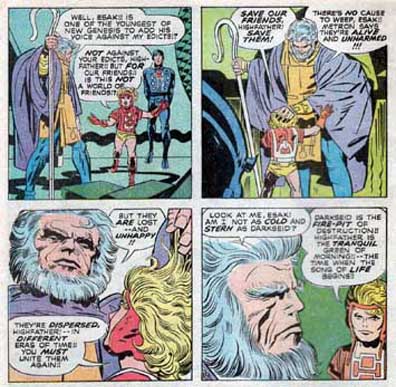
The clear view of Esak, from Forever People #7
But, Darkseid allows the Forever People to escape repeatedly, saying, “Greatness does not come from killing the young” (FP #8). When the hammer came, Kirby exiled the Forever People to a distant, verdant world and left the seemingly inevitable final battle between Darkseid and Orion hanging. Shorn of Jack’s fire, Mister Miracle limped to his belated wedding with Big Barda, presided over by a noncommittal Highfather. There was no acknowledgement of unresolved traumas such as Scott Free’s sacrifice for the sake of peace. Kirby was already elsewhere.
When in 1983 Jack was asked by DC to complete his saga in one chapter, he looked at what he had done more than a decade before and, out of all possibilities, chose the theme of the betrayal of ideals to close out his saga. The overriding theme that he saw in the New Gods tapestry is that he had hoped and believed that the young could and would tackle the evils of their day with ingenuity and compassion. As the promise of the sixties faded, these aspirations were not borne out. He watched expanded consciousness give way to drug addiction, sexual and racial equality slow in coming, wars beget more wars, the environment steadily worsen because of individual and corporate greed and exponential population growth. America was sliding through the Reagan Years. Jack’s initial, thoughtful response was a short allegory that left the mystery of his unfinished epic intact, but that condemned, with little equivocation, the failure of the generation in whom he had invested his hope.
Kirby did some of his best late-period art for “On the Road to Armagetto.” By this time Jack no longer drew supple, idealized figures; his characters seem compressed, reflecting his own physical aging, but for all that his drawing is no less vigorous. Despite the cartooniness Jack was veering towards, due in part to his most recent animation design efforts, there is none of Kirby’s usual humor in this piece. It’s dead serious. Kirby’s blackspotting becomes abstract and patterned, and the open outside borders create a vignette effect, as if the entire story is a nightmare. And truly, as much is hidden as is revealed in this oddly cinematic fever dream. In Jack’s finale, the enraged Orion is only seen in flashes as he infiltrates Apokolips’ capital Armagetto and incites the slum-dwelling Lowlies to revolution.
Darkseid watches his WMD experiments, postures, mugs, and spars with Himon. An obviously significant but out-of-panel character responsible for Micro-Mark nano-bombs is revealed to be a horribly disfigured, swollen-headed Esak. Metron has deserted the child for years to study in solitude. After an accident mutilates the boy, he is thoroughly corrupted and goes over to work for Darkseid. As the mob approaches, Darkseid turns tail and escapes, leaving Esak to face the killing machine Orion. Esak attempts to murder Orion’s posse, then testifies to his misfortunes
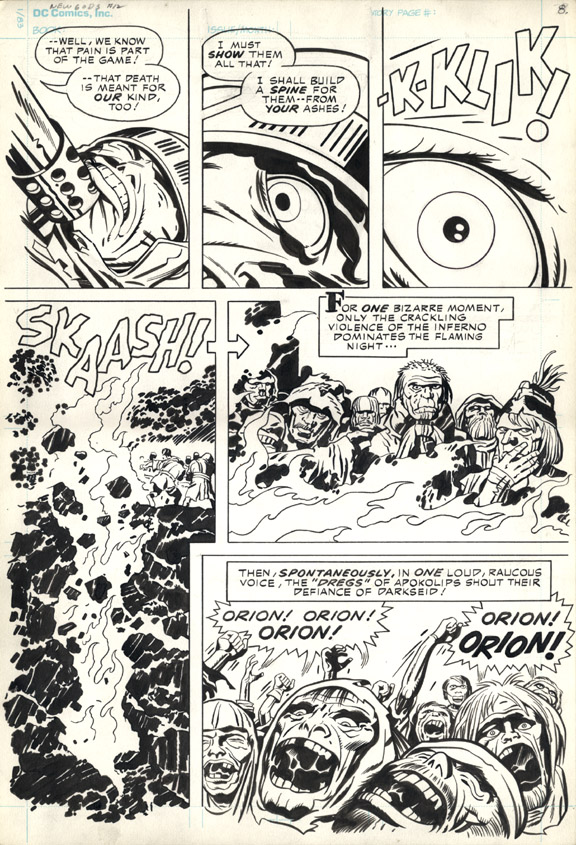
The Lowlies rise, from On the Road to Armagetto, 1982
Esak’s fall, from On the Road to Armagetto, 1982
The story Kirby originally submitted ended with the splash on page 23 of Orion on top of a pile of corpses, shooting the off-image Esak. This is Jack’s “holocaust borne on flowers”, his answer to the “nature vs. nurture” questions he had brought up with his DNA Project and the Pact. Orion’s upbringing is completely negated by his Apokoliptic genetic baggage. The flower children do not save the world, perhaps because New Genesis doesn’t care about or keep track of its children. This was intended to be Jack’s final word, then: a fatalistic burst of ultraviolence more akin to Sam Peckinpah and the Druillet books that he admired.
No doubt Kirby felt it was his prerogative to finish his epic in his own way. Over a long career he had proved time and time again that his ideas and instincts were sound. His problems occurred when he was being second-guessed. Still, after DC rejected the story, a second denial of his New Gods, Kirby persevered. The “piece of the action for redesign” deal DC gave him was unprecedented, so he did what he could to satisfy their wishes. The story mutated into an intro to Hunger Dogs. He added two moving pages wherein Orion regains his senses and absolves Esak, mitigating the darkness somewhat. The “child, fallen upon cruel days” grew away from the Source, but is forgiven. Orion witnesses the Source do a cosmetic makeover of Esak’s ravaged husk, saying, “Judge him as he was, not as he became.”
On one level Kirby apparently came to grips with his disappointment with the Hippie generation, on another, with the interruption of his opus. On yet another level he is still defiant, in effect disclaiming to the reader all of the presumptions made on his characters by others, and perhaps even what was to follow in the adulterated Hunger Dogs. The final printed graphic novel has its own merits, but reflects much interference with Kirby’s creative process. “On the Road to Armagetto” is Jack Kirby’s dark codetta to the New Gods, an apotheosis of unending conflict.”
The end
Previous – 21. Brand New World | Top | Next – 23. Why Did The Fourth World Fail?


